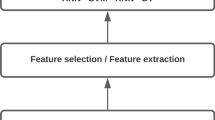Abstract
Computational intelligence shows its ability for solving many real-world problems efficiently. Synergism of fuzzy logic, evolutionary computation, and neural network can lead to development of a computational efficient and performance-rich system. In this paper, we propose a new approach for solving the human recognition problem that is the fusion of evolutionary fuzzy clustering and functional modular neural networks (FMNN). Evolutionary searching technique is applied for finding the optimal number of clusters that are generated through fuzzy clustering. The functional modular neural network has been used for recognition process that is evaluated with the help of integration based on combining the outcomes of FMNN. Performance of the proposed technique has been empirically evaluated and analyzed with the help of different parameters.








Similar content being viewed by others
References
Handl J, Knowles J (2007) An evolutionary approach to multi-objective clustering. IEEE Trans Evol Comput 11(1):56–76
Bhattacharjee D, Basu DK, Nasipuri M, Kundu M (2010) Human face recognition using fuzzy multilayer perceptron. Soft Comput 14:559–570
Lu J, Yuan X, Yahagi T (2007) A method of face recognition based on fuzzy c mean clustering and associated sub-NNs. IEEE Trans Neural Netw 18(1):152–160
Hruschka ER, Campello RJGB, Freitas AA, de Carvelho ACPLF (2009) A survey of evolutionary algorithms for clustering. IEEE Trans System Man Cybern Part C Appl Rev 39(2):133–155
Bevilacqua V, Cariello L, Carro G, Daleno D, Mastronardi G (2008) A face recognition system based on pseudo 2D HMM applied to neural network coefficient. Soft Comput J 12:615–621
Luh G-C, Lin C-Y (2011) PCA based immune networks for human face recognition. Appl Soft Compu 11:1743–1752
Gaxiola F, Melin P (2010) Modular neural networks for person recognition using segmentation and the iris biometric measurement with image preprocessing. IEEE world congress on computational intelligence, Spain, pp 1–6
Tripatrhi BK, Kalra PK (2010) Functional mapping with higher order compensatory neuron model. IEEE world congress on computational intelligence, Spain
Deb K (2001) Multi-objective optimization using evolutionary algorithms. Wiley, New York
Fazendeiro P, de Oliveira JV (2007) A semantic driven evolutive fuzzy clustering algorithm. In: Proceedings of the IEEE International Conference Fuzzy System, pp 1–6
Groenen PJF, Jajuga K (2001) Fuzzy clustering with squared minkowski distances. Fuzzy Sets Syst 120:227–237
AT & T Cambridge face database, http://www.camorl.co.uk/facedatabase.html
Tripathi BK, Kalra PK (2010) The novel aggregation function based neuron models in complex domain. Soft Comput 14:1069–1081
Mingoti SA, Lima JO (2006) Comparing SOM neural network with Fuzzy c-means, K-means and traditional hierarchical clustering algorithms. Eur J Oper Res 174(2006):1742–1759
Zhang BL, Zhang H, Ge SS (2004) Face recognition by applying wavelet subband representation and kernel associative memory. IEEE Trans Neural Netw 15(1):166–177
Liu Q, Tang X, Lu H, Ma S (2006) Face recognition using kernel scatter difference based discriminant analysis. IEEE Trans Neural Netw 17(4):1081–1085
Yu J, Cheng Q, Hung H (2004) Analysis of weighting exponent in the FCM. IEEE Trans Syst Man Cybern B Cybern 34(1):634–638
Institute of Automation of chinese academy of sciences (CASIA) iris database, http://www.cbsr.ia.ac.cn/english/Irisdatabase.asp
Lu J, Plataniotis KN, Venetsanopoulos AN (2003) Face recognition using LDA based algorithms. IEEE Trans Neural Netw 14(1):195–200
Li SJ, Lu J (1999) Face recognition using nearest feature line method. IEEE Trans Neural Netw 10(2):439–445
Er MJ, Wu S, Lu J, Toh HL (2002) Face recognition with radial basis function RBF neural network. IEEE Trans Neural Netw 13(3):697–710
Sirlantzis K, Hoque S, Fairhurst MC (2008) Diversity in multiple classifier ensembles based on binary feature quantisation with application to face recognition. Appl Soft Comput 8(1):437–445
Zuo W, Wang K, Zhang D, Zhang H (2007) Combination of two novel LDA-based methods for face recognition. Neurocomputing 70(4–6):735–742
Tseng LY, Yang SB (2001) A genetic approach to the automatic clustering problem. Pattern Recogn 34:415–424
Turk MA, Pentland AP (1991) Eigen faces for recognition. J Cogn Neurosci 3:71–86
Tripathi BK, Kalra PK (2011) On efficient learning machine with root-power mean neuron in complex-domain. IEEE Trans Neural Netw 22(5):727–738
Tripathi BK, Kalra PK (2011) On the learning machine for three dimensional mapping. Neural Comput Appl 20:105–111
Author information
Authors and Affiliations
Corresponding author
Rights and permissions
About this article
Cite this article
Srivastava, V., Tripathi, B.K. & Pathak, V.K. Evolutionary fuzzy clustering and functional modular neural network-based human recognition. Neural Comput & Applic 22 (Suppl 1), 411–419 (2013). https://doi.org/10.1007/s00521-012-0973-7
Received:
Accepted:
Published:
Issue Date:
DOI: https://doi.org/10.1007/s00521-012-0973-7




